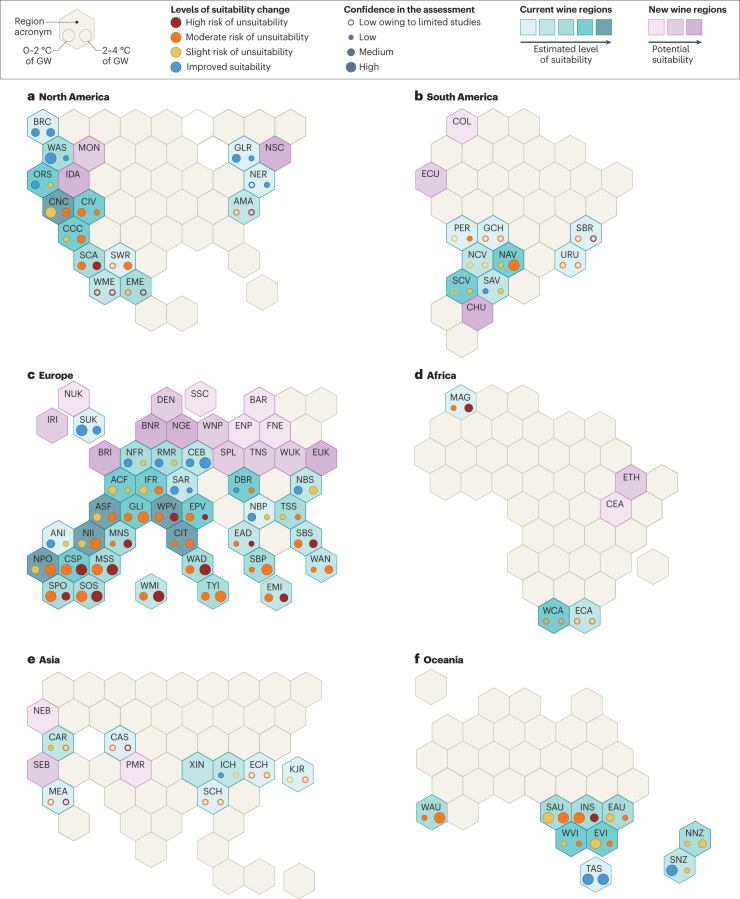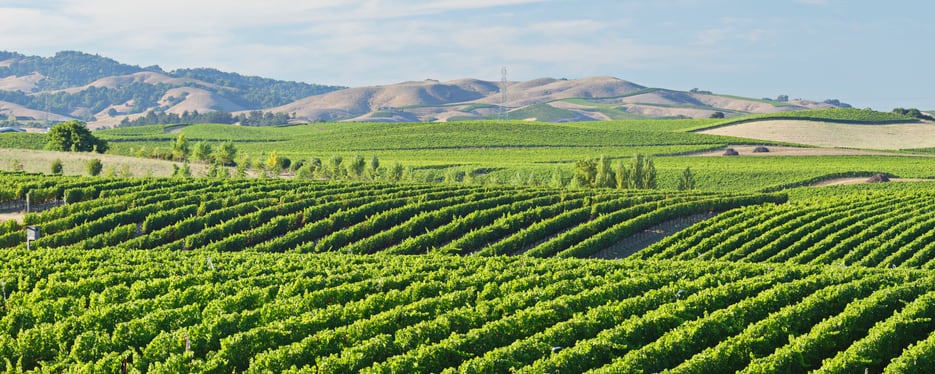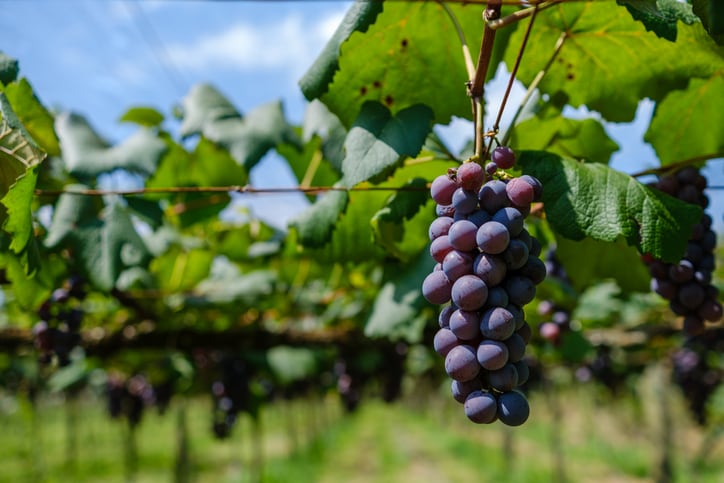While some 90% of coastal and low-altitude regions in Europe and California may no longer be able to produce wine economically, other regions such as British Columbia in Canada and Washington State could become increasingly important.
Researchers from French scientific bodies - inlcuding INRAE (the French public research institute for agriculture, food and environment research), Bordeaux Sciences Agro, CNRS (Centre national de la recherche scientifique), Université de Bordeaux and Université de Bourgogne – have worked together to create the map of wine production in the future.
They conclude that, on every continent, ‘there will be winners and losers’.
Shifting wine regions
Current wine-growing regions are primarily located at mid-latitudes (California, USA; southern France; northern Spain and Italy; Barossa, Australia; Stellenbosch, South Africa; and Mendoza, Argentina, among others), where the climate is warm enough to allow grape ripening, but without excessive heat, and relatively dry (minimizing the likelihood of disease).
But changes are already being seen: harvesting in most vineyards now begins two to three weeks earlier than it did 40 years ago, with effects on grapes and the resulting styles of wines. In France - where records have been kept for centuries - scientists have been able to track the change of climate through the recorded dates of grape harvests back to 1354.
And suitability for wine production in established winegrowing regions is likely to change far more dramatically during the twenty-first century. In fact, 90% of traditional wine regions in coastal and lowland regions of Spain, Italy, Greece and southern California could be at risk of disappearing by the end of the century because of excessive drought and frequent heatwaves.
With that comes ‘enormous negative social and economic consequences’.
Where can grapes grow?
Wine grapes are cultivated from the tropics to Scandinavia and can be grown at elevations of over 3,000 m, revealing the 'remarkable adaptability' of grapevine to a wide range of climate conditions, note researchers (The Guinness World Book of Records puts the highest vineyard at 3,563.31m / 11,690ft in Tibet).
Finding new wine regions is not simply about changing latitudes: it's about finding suitable altitudes or areas with suitable weather currents.
But warmer temperatures might increase suitability for other regions.
The UK has already identified an opportunity for wine: vineyard area across Britain has increased 74% over the last five years with viticulture now representing one of the UK's fastest growing agricultural sectors, according to WineGB.
Other regions set to become increasingly prosperous for wine include Washington State and Oregon in the US, Tasmania in Australia, and northern parts of France. It could also see southward movement into Argentinian Patagonia, or exploration of high altitudes in the Ecuadorian and Colombian Andes.
The researchers considered two scenarios: one where temperatures increase up to 2 °C, and a higher warming scenario with increases of 4 °C, and looked at how wine regions can be expected to change throughout the 21st century.
On a global scale, approximately 25% of current wine regions might benefit from a temperature increase capped at 2 °C, and around 26% are likely to maintain their current suitability with proper management practices.
“This implies that global warming levels below 2 °C can be deemed a safe threshold for over half of traditional vineyards,” note researchers. Conversely, for temperature increases beyond 2 °C, 70% of existing winemaking regions might face substantial risks of suitability loss.
Specifically, 29% might experience too extreme climate conditions, preventing premium wine production, while the future of the remaining 41% will hinge on the effective feasibility of effective adaptation measures.

North America: California shake-up
North American wine production (responsible for around 10% of global production) is currently concentrated in California, including the famous Napa Valley. But the net suitable area for wine production in California could decline by up to 50% by the end of the 21st century.
Moderate levels of global warming would see coastal regions of California stay suitable for high-quality wine production. But these winemakers will face increasing risks of drought, heatwaves and wildfires.
But if global warming exceeds 2 °C, coastal California will transition to a very warm and arid climate for viticulture, probably resulting in a decline in wine quality and economic sustainability.

The interior regions of California are more sensitive and might experience problems earlier. The southern part of California - already characterized by a warm and dry climate - is expected to become unsuitable for high-quality wine production under global warming scenarios exceeding 2 °C.
But the northernmost wine regions of the continent – such as British Columbia, Washington State, Oregon, the Great Lakes and New England – will see their potential for premium wine production rise, thanks to a shift from cool to intermediate (or even warm) climate viticulture.
But this only applies up to 2 degrees C: after this point, the risk of heatwaves and disease pressures (particularly in these humid regions) intensifies.
Europe: Shift from Mediterranean to Atlantic
Spain, France, Italy and Germany collectively account for half of global wine production.
Low levels of global warming (<2 °C) will enable most traditional wine regions to continue production, albeit with certain adaptation measures (particularly in southern Europe).
In more severe warming scenarios, most Mediterranean regions risk becoming unsuitable for wine production, and the only solution to retain vineyards below 45° N would be to relocate to higher altitudes.
But that can only compensate so far: 90% of the traditional wine regions situated in the lowlands and coastal regions of Spain, Italy and Greece could be at risk of disappearing by the end of the century; and only a minor portion of this loss (less than 20%) could theoretically be compensated for by shifting vineyards towards mountainous areas (elevations of up to 1,000 m).
Atlantic regions are less vulnerable: and new regions could emerge in this area (however, that calculation is solely theoretical and based on climate: rather than considering factors such as soil quality, pre-existing land use and other crucial factors).
Overall, the suitable surface area of traditional wine-producing regions is expected to decline by 20–70% by the end of the century, depending on the severity of the warming scenario. Simultaneously, new wine regions are expected to expand northward, notably along the Atlantic sector, resulting in a net increase of climatically suitable areas in Europe by up to 60%.
Kenyan wine
Africa and Asia currently count for a low level of wine production (3.8% and 3.5% respectively). Potential emerging wine regions in Africa include the highlands of Kenya and Ethiopia, where the wine industry is at the early stage of development. In Asia, emerging regions with potential include the northeastern Black Sea coasts, eastern Anotolia and Pamir-Himalayan Mountains.
Overall, depending on the degree of global warming, up to 65% of the traditional Australian vineyards might become climatically unsuitable, whereas wine-producing regions in New Zealand have the potential to expand by 15–60% by the end of the century
Learning to adapt
The key question will be how quickly and dramatically changes take place – which depends on the level of temperature rise.
And researchers acknowledge that some of their projects may be overly pessimistic, because they no not take into account the possibility for growers to adapt to changing conditions.
Existing wine regions may be able to adapt to a certain level of warming by changing plant material (varieties and rootstocks such as drought-resistant plant material), training systems and vineyard management.
Wine quality is very sensitive to temperature during grape ripening, so shifting weather patterns can be expected to change the taste, aroma and quality of wine (low temperatures during grape ripening typically lead to green and acidic profiles, while high temperatures lead to high alcohol and low acidity, featuring cooked fruit aromas instead of fresh fruit).
And while the research throws up potential for new wine regions, these need to be created sustainably. Wild habitats may be threatened when space is cleared for vineyards; and even converting existing farmland to winegrowing means less arable land dedicated to food production. If new vineyards are irrigated, this will increase competition for freshwater resources.
Source:
Climate change impacts and adaptations of wine production
Authors: Van Leeuwen, C., Sgubin, G., Bois, B. et al.
Published March 26, 2024, Nat Rev Earth Environ

